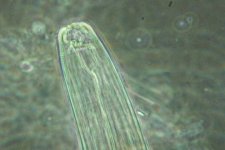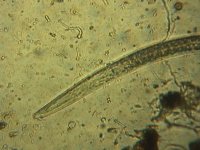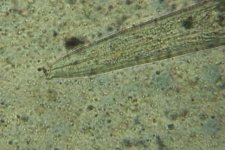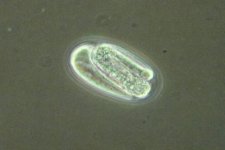Tactical Farmer
Member
Fungal-feeding nematodes have small, narrow stylets, or spears, in their stoma (mouth) which they use to puncture thecell walls of fungal hyphae and withdraw the cell fluid. This interaction releases plant-available nitrogen from fungal biomass.
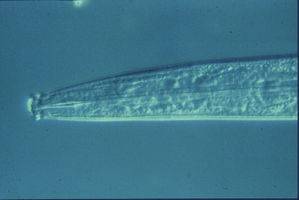
This bacterial-feeding nematode, Elaphonema, has ornate lip structures that distinguish it from other nematodes. Bacterial-feeders release plant-available nitrogen when they consume bacteria.
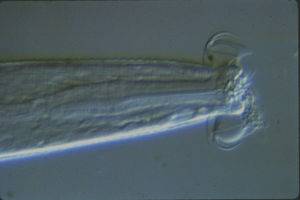
Root-feeding nematodes use their stylets to puncture the thick cell wall of plant root cells and siphon off the internal contents of the plant cell. This usually causes economically significant damage to crops. The curved stylet seen inside this nematode is characteristic of the genus Trichodorus.
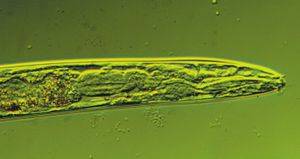
The Pratylenchus, or lesion nematode, has a shorter, thicker stylet in its mouth than the root feeder
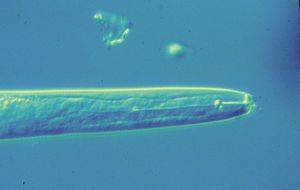
Most nematodes in the soil are not plant parasites. Beneficial nematodes help control disease and cycle nutrients.
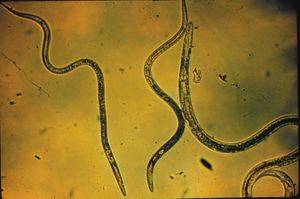
___________________________________________________________________
THE LIVING SOIL: NEMATODES
Nematodes are non-segmented worms typically 1/500 of an inch (50 µm) in diameter and 1/20 of an inch (1 mm) in length. Those few species responsible for plant diseases have received a lot of attention, but far less is known about the majority of the nematode community that plays beneficial roles in soil.
An incredible variety of nematodes function at several trophic levels of the soil food web. Some feed on the plants and algae (first trophic level); others are grazers that feed on bacteria and fungi (second trophic level); and some feed on other nematodes (higher trophic levels).
Free-living nematodes can be divided into four broad groups based on their diet. Bacterial-feeders consume bacteria. Fungal-feeders feed by puncturing the cell wall of fungi and sucking out the internal contents. Predatory nematodes eat all types of nematodes and protozoa. They eat smaller organisms whole, or attach themselves to the cuticle of larger nematodes, scraping away until the prey’s internal body parts can be extracted. Omnivores eat a variety of organisms or may have a different diet at each life stage. Root-feeders are plant parasites, and thus are not free-living in the soil.
WHAT DO NEMATODES DO?
Nutrient cycling. Like protozoa, nematodes are important in mineralizing, or releasing, nutrients in plant-available forms. When nematodes eat bacteria or fungi, ammonium (NH4+) is released because bacteria and fungi contain much more nitrogen than the nematodes require.
Grazing. At low nematode densities, feeding by nematodes stimulates the growth rate of prey populations. That is, bacterial-feeders stimulate bacterial growth, plant-feeders stimulate plant growth, and so on. At higher densities, nematodes will reduce the population of their prey. This may decrease plant productivity, may negatively impact mycorrhizal fungi, and can reduce decomposition and immobilization rates by bacteria and fungi. Predatory nematodes may regulate populations of bacterial-and fungal-feeding nematodes, thus preventing over-grazing by those groups. Nematode grazing may control the balance between bacteria and fungi, and the species composition of the microbial community.
Dispersal of microbes. Nematodes help distribute bacteria and fungi through the soil and along roots by carrying live and dormant microbes on their surfaces and in their digestive systems.
Food source. Nematodes are food for higher level predators, including predatory nematodes, soil microarthropods, and soil insects. They are also parasitized by bacteria and fungi.
Disease suppression and development. Some nematodes cause disease. Others consume disease-causing organisms, such as root-feeding nematodes, or prevent their access to roots. These may be potential biocontrol agents.
WHERE ARE NEMATODES?
Nematodes are concentrated near their prey groups. Bacterial-feeders abound near roots where bacteria congregate; fungal-feeders are near fungal biomass; root-feeders are concentrated around roots of stressed or susceptible plants. Predatory nematodes are more likely to be abundant in soils with high numbers of nematodes.
Because of their size, nematodes tend to be more common in coarser-textured soils. Nematodes move in water films in large (>1/500 inch or 50 µm) pore spaces.
Agricultural soils generally support less than 100 nematodes in each teaspoon (dry gram) of soil. Grasslands may contain 50 to 500 nematodes, and forest soils generally hold several hundred per teaspoon. The proportion of bacterial-feeding and fungal-feeding nematodes is related to the amount of bacteria and fungi in the soil. Commonly, less disturbed soils contain more predatory nematodes, suggesting that predatory nematodes are highly sensitive to a wide range of disturbances.
NEMATODES AND SOIL QUALITY
Nematodes may be useful indicators of soil quality because of their tremendous diversity and their participation in many functions at different levels of the soil food web. Several researchers have proposed approaches to assessing the status of soil quality by counting the number of nematodes in different families or trophic groups.* In addition to their diversity, nematodes may be useful indicators because their populations are relatively stable in response to changes in moisture and temperature (in contrast to bacteria), yet nematode populations respond to land management changes in predictable ways. Because they are quite small and live in water films, changes in nematode populations reflect changes in soil microenvironments.
http://www.google.com/imgres?imgurl...0&sa=X&oi=image_result&resnum=1&ct=image&cd=1
This bacterial-feeding nematode, Elaphonema, has ornate lip structures that distinguish it from other nematodes. Bacterial-feeders release plant-available nitrogen when they consume bacteria.
Root-feeding nematodes use their stylets to puncture the thick cell wall of plant root cells and siphon off the internal contents of the plant cell. This usually causes economically significant damage to crops. The curved stylet seen inside this nematode is characteristic of the genus Trichodorus.

The Pratylenchus, or lesion nematode, has a shorter, thicker stylet in its mouth than the root feeder

Most nematodes in the soil are not plant parasites. Beneficial nematodes help control disease and cycle nutrients.

___________________________________________________________________
THE LIVING SOIL: NEMATODES
Nematodes are non-segmented worms typically 1/500 of an inch (50 µm) in diameter and 1/20 of an inch (1 mm) in length. Those few species responsible for plant diseases have received a lot of attention, but far less is known about the majority of the nematode community that plays beneficial roles in soil.
An incredible variety of nematodes function at several trophic levels of the soil food web. Some feed on the plants and algae (first trophic level); others are grazers that feed on bacteria and fungi (second trophic level); and some feed on other nematodes (higher trophic levels).
Free-living nematodes can be divided into four broad groups based on their diet. Bacterial-feeders consume bacteria. Fungal-feeders feed by puncturing the cell wall of fungi and sucking out the internal contents. Predatory nematodes eat all types of nematodes and protozoa. They eat smaller organisms whole, or attach themselves to the cuticle of larger nematodes, scraping away until the prey’s internal body parts can be extracted. Omnivores eat a variety of organisms or may have a different diet at each life stage. Root-feeders are plant parasites, and thus are not free-living in the soil.
WHAT DO NEMATODES DO?
Nutrient cycling. Like protozoa, nematodes are important in mineralizing, or releasing, nutrients in plant-available forms. When nematodes eat bacteria or fungi, ammonium (NH4+) is released because bacteria and fungi contain much more nitrogen than the nematodes require.
Grazing. At low nematode densities, feeding by nematodes stimulates the growth rate of prey populations. That is, bacterial-feeders stimulate bacterial growth, plant-feeders stimulate plant growth, and so on. At higher densities, nematodes will reduce the population of their prey. This may decrease plant productivity, may negatively impact mycorrhizal fungi, and can reduce decomposition and immobilization rates by bacteria and fungi. Predatory nematodes may regulate populations of bacterial-and fungal-feeding nematodes, thus preventing over-grazing by those groups. Nematode grazing may control the balance between bacteria and fungi, and the species composition of the microbial community.
Dispersal of microbes. Nematodes help distribute bacteria and fungi through the soil and along roots by carrying live and dormant microbes on their surfaces and in their digestive systems.
Food source. Nematodes are food for higher level predators, including predatory nematodes, soil microarthropods, and soil insects. They are also parasitized by bacteria and fungi.
Disease suppression and development. Some nematodes cause disease. Others consume disease-causing organisms, such as root-feeding nematodes, or prevent their access to roots. These may be potential biocontrol agents.
WHERE ARE NEMATODES?
Nematodes are concentrated near their prey groups. Bacterial-feeders abound near roots where bacteria congregate; fungal-feeders are near fungal biomass; root-feeders are concentrated around roots of stressed or susceptible plants. Predatory nematodes are more likely to be abundant in soils with high numbers of nematodes.
Because of their size, nematodes tend to be more common in coarser-textured soils. Nematodes move in water films in large (>1/500 inch or 50 µm) pore spaces.
Agricultural soils generally support less than 100 nematodes in each teaspoon (dry gram) of soil. Grasslands may contain 50 to 500 nematodes, and forest soils generally hold several hundred per teaspoon. The proportion of bacterial-feeding and fungal-feeding nematodes is related to the amount of bacteria and fungi in the soil. Commonly, less disturbed soils contain more predatory nematodes, suggesting that predatory nematodes are highly sensitive to a wide range of disturbances.
NEMATODES AND SOIL QUALITY
Nematodes may be useful indicators of soil quality because of their tremendous diversity and their participation in many functions at different levels of the soil food web. Several researchers have proposed approaches to assessing the status of soil quality by counting the number of nematodes in different families or trophic groups.* In addition to their diversity, nematodes may be useful indicators because their populations are relatively stable in response to changes in moisture and temperature (in contrast to bacteria), yet nematode populations respond to land management changes in predictable ways. Because they are quite small and live in water films, changes in nematode populations reflect changes in soil microenvironments.
http://www.google.com/imgres?imgurl...0&sa=X&oi=image_result&resnum=1&ct=image&cd=1
Last edited:

